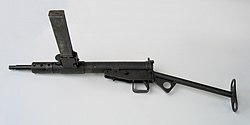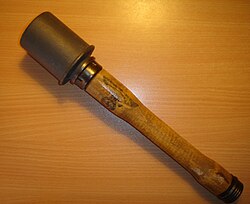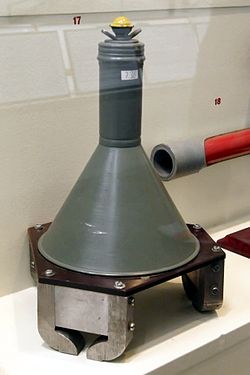Sidearms
| Picture | Name | Manufacturer | Cartridge | Primary User | Note | References |
|---|---|---|---|---|---|---|
 | Astra 300 | Astra-Unceta y Cia SA | 7.65×17mm SR 9×17mm Kurz | Luftwaffe | 85,390 delivered from 1941 to 1944. [1] | [2] |
| Astra 400 | Astra-Unceta y Cia SA | 9×23mm Largo | Luftwaffe | 6,000 purchased in 1941. [1] | [3] | |
 | Astra 600 | Astra-Unceta y Cia SA | 9×19mm Parabellum | Luftwaffe | 10,450 Astra 600s had been delivered to Germany until German occupation of France ceased. [4] The remainder of the German order, consisting of 28,000 pistols, was intercepted by Allied forces in September 1944. [1] | [3] |
 | Astra 900 | Astra-Unceta y Cia SA | 7.63×25mm Mauser | Wehrmacht | 1,050 delivered in March 1943. | [1] |
 | Browning Hi-Power | Fabrique Nationale d'Herstal | 9×19mm Parabellum | Waffen-SS Fallschirmjäger | 319,000 manufactured under German occupation. Designated Pistole 640(b) in German service. | [5] |
 | ČZ vz. 27 | Böhmische Waffenfabrik (Czech made under German occupation (after mid-March 1939)) | 7.65 mm Browning/.32 ACP | Wehrmacht Gestapo | All ČZ 27's Produced for German use were all marked on the slide with "Pistole Modell 27 Kal 7.65" with the addition of "Böhmische Waffenfabrik Prag." | - |
 | Dreyse M1907 | Rheinmetall | 7.65×17mm SR | Wehrmacht | Only a few thousands of the pistols were produced during WW2 | [6] |
 | FÉG 37M | Fémárú, Fegyver- és Gépgyár | 7.65×17mm SR | Luftwaffe | Examples produced for German use included a manual safety, which was absent from the Hungarian-issue version. Designated Pistole 37(u) in German service. | [7] |
 | FN Model 1910 | Fabrique Nationale de Herstal | 7.65×17mm Browning | Wehrmacht Luftwaffe | The FN M1910 was produced under the German occupation. Designated "Pistole 621" in German service. | - |
 | FN Model 1922 | Fabrique Nationale de Herstal | 7.65×17mm Browning 9×17mm Browning | Wehrmacht Luftwaffe Waffen-SS | The FN M1922 was mainly produced for the Luftwaffe, Also used by Wehrmacht, SS, Reich Government Officials, but oddly enough was still sold commercially up until 1942. | - |
 | Kongsberg Colt | Kongsberg Vaapenfabrikk | 11.43x23mm ACP | Wehrmacht | 8,200 were produced during German occupation. Designated as Pistole 657(n) in German service. | - |
 | Luger P08 pistol | Deutsche Waffen und Munitionsfabriken Mauser-Werke | 9×19mm Parabellum | Wehrmacht Luftwaffe Waffen-SS | The Luger P08's production was taken over by Mauser after World War I. [8] | [9] |
 | Luger M1902 Carbine | Deutsche Waffen und Munitionsfabriken Mauser-Werke | 9x19mm Parabellum | Wehrmacht Waffen-SS | A few were seen used by the Wehrmacht and Waffen-SS in 1944. | |
 | Mauser HSc | Mauser-Werke | 7.65×17mm SR | Kriegsmarine Deutsches Heer Luftwaffe Waffen-SS Gestapo Kriminalpolizei | Originally produced as a commercial pistol, The Mauser HSc was fully adopted by the Kriegsmarine, Luftwaffe, Deutsches Heer (German Army), the Waffen-SS the Gestapo and the Kriminalpolizei in 1943. [10] | [11] |
 | Mauser C96 | Mauser-Werke | 7.63×25mm Mauser 9×19mm Parabellum | Wehrmacht Waffen-SS Luftwaffe | The Mauser C96 was adopted in 1942 and the M1930 variant was delivered to the Luftwaffe. | [11] |
 | MAB Model D | Manufacture d'Armes de Bayonne | 7.65×17mm Browning SR | Wehrmacht | After German forces occupied France, the MAB Model D was adopted for use by the Wehrmacht during World War II. | |
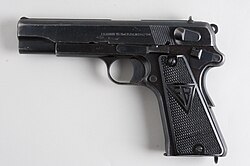 | Radom wz.35 Vis | Łucznik Arms Factory, Radom | 9×19mm Parabellum | Fallschirmjäger Feldgendarmerie | Designated Pistole 645(p) in German service. | [12] |
 | Steyr M1912 | Steyr Mannlicher | 9×19mm Parabellum 9×23mm Steyr | Wehrmacht | When the Austrian Army was absorbed, existing Steyr M1912 pistols were rechambered to fire 9mm Parabellum rounds. [13] Designated Pistole 12(ö) in German service. | [14] > |
 | Sauer 38H | Sauer & Sohn | 7.65×17mm SR | Wehrmacht Luftwaffe | The manual safety on the Sauer 38H was excluded on pistols produced between 1944 and 1945. [13] | [15] |
 | Star Model B | Star Bonifacio Echeverria | 9×19mm Parabellum | Luftwaffe | Similar to the Colt M1911 and 25,000 delivered prior to liberation of France. | [1] |
| - | Volkspistole | Mauser-Werke Carl Walther GmbH Gustloff-Werke | 9×19mm Parabellum | - | An emergency weapon production can be traced to Mauser and Walther, but full identification is still uncertain. [16] | [17] |
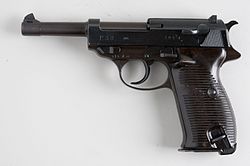 | Walther P38 | Carl Walther GmbH Mauser-Werke Spreewerke GmbH | 9×19mm Parabellum | Wehrmacht Luftwaffe Waffen-SS Gestapo Kriminalpolizei | The standard issue pistol of the Wehrmacht. [18] | [19] |
 | Walther PP | Carl Walther GmbH | 7.65×17mm SR | Wehrmacht Luftwaffe Waffen-SS Gestapo Kriminalpolizei | Produced and used by Wehrmacht, Luftwaffe, Waffen-SS, the Gestapo and the Kriminalpolizei in WW2. | [19] |
 | Walther PPK | Carl Walther GmbH | 7.65×17mm SR 9×17mm Kurz | Wehrmacht Luftwaffe Waffen-SS Gestapo Kriminalpolizei | Similar to the PP but shorter version used mostly by Kriminalpolizei during WW2. | |
 | Walther Model 8 | Carl Walther GmbH | .25 ACP | Luftwaffe Panzerwaffe | 3,090 pistols were delivered to the Luftwaffe and the Panzerwaffe in 1941. | |
 | Walther Model 9 | Carl Walther GmbH | .25 ACP | Wehrmacht Luftwaffe Panzerwaffe | 298 pistols were delivered to the Wehrmacht in 1940-1945. | |
 | Pistolet automatique modèle 1935A | Société Alsacienne de Constructions Mécaniques | 7.65×20mm Longue | Wehrmacht | Captured in 1944 and designated as Pistole 625(f). | |
 | Colt M1911 | Colt Manufacturing Company | .45 ACP | Wehrmacht Volkssturm | Designated as Pistole 660(a). | |
 | Smith & Wesson M1917 | Smith & Wesson | .45 ACP | Wehrmacht Volkssturm | Designated as Revolver 661(a). | |
 | Colt M1917 | Colt Manufacturing Company | .45 ACP | Wehrmacht Volkssturm | Designated as Revolver 662(a). | |
 | Bodeo M1889 Revolver | Societa Siderurgica Glisenti | 10.35mm Ordinanza Italiana | Wehrmacht | A revolver produced in Kingdom of Italy in WW1, some these revolvers were used by the Wehrmacht and designated as Revolver 680(i). |












































